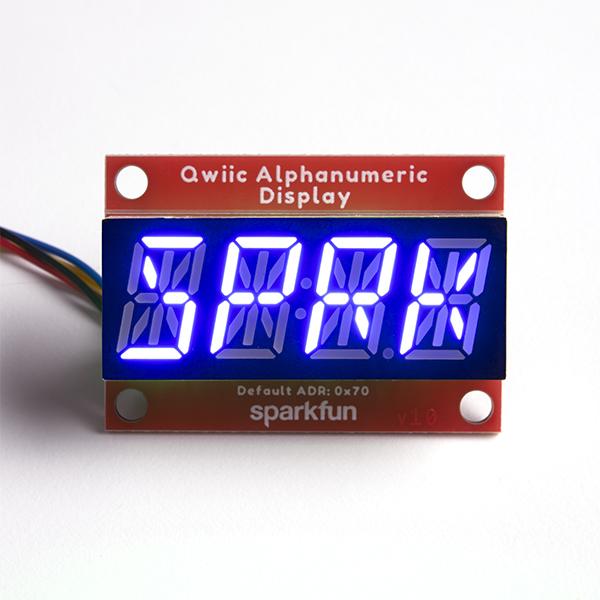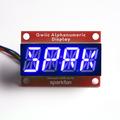SparkFun Qwiic Alphanumeric Display - Blue

Description Attachments
The SparkFun Qwiic Alphanumeric Display is a blue fourteen-segment display that goes beyond the standard seven-segment displays found on items like alarm clocks and microwaves. This advanced display can showcase not just numbers, but a wide range of characters and symbols as well. With the convenience of the Qwiic system, it's a plug-and-play device that eliminates the need for soldering or figuring out SDA or SCL connections, and it doesn't require voltage regulation or translation.The SparkFun Alphanumeric Display Arduino library simplifies the process of printing strings to the display. All it takes is a simple print() function call. This library also allows for sending I2C commands to the VK16K33 LED driver chip, enabling the lighting up of segments, including decimal points or colons, and even scrolling the string across the display. The library can be downloaded through the Arduino library manager by searching 'SparkFun Alphanumeric Display' or from the GitHub repo as a .zip file.The VK16K33 supports I2C address configuration, with the ability to close a combination of the address jumpers on the back, enabling communication with up to four displays on the same bus. The slim board design features detachable stand-off holes, vertical Qwiic connectors, and internal mounting holes.The SparkFun Qwiic Connect System is an ecosystem of I2C sensors, actuators, shields, and cables that simplify prototyping and reduce errors. All Qwiic-enabled boards use a common 1mm pitch, 4-pin JST connector, minimizing required PCB space. The polarized connections also prevent incorrect hookups.The Qwiic Alphanumeric Display features a blue display, operates at 3.3V, and includes an integrated RC oscillator. It can display a maximum of 128 patterns, has a 13×3 matrix key scan circuit, a 16-step dimming circuit, and I2C Addresses: 0x70 (0x71, 0x72, 0x73). The display also comes with 2x Qwiic connectors and 2x wall mounting points. The package includes a schematic, Eagle Files, board dimensions, hookup guide, datasheet (VK16K33), Qwiic Info Page, Arduino Library, and GitHub Hardware Repo.
Properties
Brand information
| Brand | Sparkfun |
| Model | COM-16917 |
| More info | SparkFun Qwiic Alphanumeric Display Hookup Guide - SparkFun Learn |
Size info
| Length | 29 mm |
| Width | 42 mm |
| Height | 15 mm |
| Weight | 23,7 g |
€ 13,75€ 11,40 Excl. VAT (NL)
Customer questions
Q
Customer Reviews
SparkFun Qwiic Alphanumeric Display - Blue ★★★★★Click a star to leave your review
- In stock Sparkfun Hobby Motor - Gear € 3,50 View product
- In stock Sparkfun Thin Speaker - 4 Ohm, 2.5W, 28mm € 3,- View product
- In stock SparkFun SOIC to DIP Adapter - 20-Pin € 6,25 View product
- In stock Sparkfun Teensy Stackable Header Kit (Extended) € 2,90 View product
- In stock SparkFun Logic Level Converter - Bi-Directional € 5,15 View product
- In stock Sparkfun Copper Tape - Conductive Adhesive, 5mm - 15 meter € 7,75 View product
- In stock Sparkfun Thumb Joystick Knob - Deluxe € 1,90 View product
- In stock SparkFun Micro 6DoF IMU Breakout - BMI270 (Qwiic) € 21,75 View product
- In stock Sparkfun Slide Pot - Medium (10k Linear Taper) € 3,05 View product
- In stock Sparkfun Battery Holder 2xAA with Cover and Switch - JST Connector € 2,60 View product
- In stock Sparkfun Hall-Effect Sensor - AH1815 (Non-Latching) € 1,90 View product
- In stock Sparkfun Jumper Wires - Connected 6" (M/M, 20 pack) € 5,10 View product
- In stock SparkFun Audio Jack Breakout € 2,- View product
- In stock Sparkfun LED - Ultraviolet € 2,15 View product
- In stock Sparkfun Ribbon Cable - 10 wire (3ft) € 2,- View product










